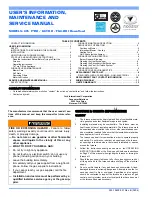
Page 17
Condenser coil may need to be cleaned at startup in
case oil from the manufacturing process is found on the
condenser coil.
Burners
To clean the burners, first remove them from the furnace
as explained in the Burner and Burner Orifice Instructions
section. Vacuum and/or brush as required.
Vent Outlet
Visually inspect vent outlet periodically to make sure that
there is no buildup of soot or dirt. If necessary, clean to
maintain adequate opening to discharge flue products.
Heat Exchanger
With proper combustion adjustment, the heat exchanger
of a gas-fired furnace will seldom need cleaning. Sooting
of a gas appliance is highly irregular and once cleaned,
the cause of the sooting must be determined. If the heat
exchanger should become sooted, it can be cleaned as
follows:
1. Remove the burner assembly as outlined in the Burner
and Burner Orifice Instructions section.
2. Remove the combustion blower.
3. At the bottom of the heating section, remove the screws
holding the flue collector box. Carefully remove the flue
collector box without ripping the adjacent insulation.
4.
Using a wire brush on a flexible wand, brush out the
inside of each heat exchanger from the burner inlet
and flue outlet ends.
5.
Brush out the inside of the flue collector box.
6. Run the wire brush down the heat exchanger tubes
from the flue collector end.
7. If soot buildup is excessive, remove the vent motor and
clean the wheel and housing. Run the wire brush down
the flue extension at the outlet of the vent housing.
8. After brushing is complete, blow all brushed areas with
air. Vacuum as needed.
9. Replace parts in the reverse order they were removed
in Steps 1 through 3.
10.
When replacing the flue collector box, be careful so as
not to tear the adjoining insulation.
11. Assure that all joints on the vent side of the combustion
system are air tight. Apply a high temperature (+500°F)
sealing compound where needed.
Control System Diagnostics
Table 4. Fault Codes
LED Status
Flashing Rate
Fault Description
Slow Flash
One flash per
second
Normal operation:
No call for heat
Fast Flash
Two flashes per
second
Normal operation:
Call for heat
2 Flash
Two flashes in
second with
1-second pause
System lockout:
Failed to detect or
sustain flame
3 Flash
Three flashes in
1.5 seconds with
1-second pause
Pressure switch senses
incorrect pressure or gas
valve coil is open.
4 Flash
Four flashes in
2 seconds with
1-second pause
High limit or rollout
switch open
5 Flash
Five flashes in
2.5 seconds with
1-second pause
Flame sensed and gas
valve not energized
Steady
--
Internal failure:
Micro-controller failure;
self-check
Table 5. Cooling Performance - Gas/Electric Models
80 DB / 67 WB Deg.
Return Air
Air Temperature Entering Evaporator Coil, Degree F
Cooling
Input
(1000 BTU)
Pressure
65°
70°
75°
80°
82°
85°
90°
95°
100°
105°
110°
115°
24
Suction
135
136
137
139
139
141
143
146
148
150
152
154
30
135
137
140
142
143
145
147
150
152
154
155
157
36
135
137
140
142
143
144
147
149
151
152
154
155
42
129
132
135
139
140
141
143
145
146
147
148
149
48
132
136
139
143
144
145
146
147
149
151
152
154
60
130
131
133
134
135
136
139
141
144
146
149
152
24
Liquid
250
266
282
298
304
318
340
363
388
413
438
463
30
247
269
292
314
323
336
358
380
406
432
457
483
36
250
275
301
326
336
351
375
399
423
446
470
493
42
248
271
293
316
325
339
362
385
411
436
462
487
48
265
286
308
329
338
352
376
400
427
455
482
509
60
256
276
296
316
324
340
365
386
415
438
473
503









































